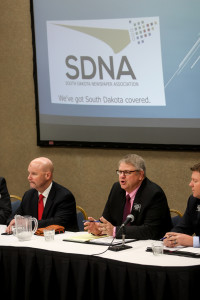
By Dana Hess
For S.D. Newspaper Association
Brookings – To fight the notion that they offer “fake news,” media outlets need to do a better job of telling the public how they gather their facts.
That was one topic journalists agreed on during a panel discussion-“Fake News: Cutting Through the Noise”-held Monday night at the South Dakota Art Museum.
“Our profession needs to do a better job of telling people what good journalism is about,” said David Bordewyk, executive director of the South Dakota Newspaper Association.
Beth Jensen, news director at KELOLAND TV, agreed, noting more transparency is needed to teach the public about the news gathering process. “I do think transparency has to become a bigger part of our vocabulary.”
Moderator Jack Marsh, a retired journalist and former executive editor of the Argus Leader, asked panel members to discuss fake news-stories that are published even though they are false-and the propensity of people to label stories they don’t agree with as “fake.”
Fake news has a long history, according to Teri Finneman, assistant professor of journalism at South Dakota State University. The first known fake news story was written by Jonathan Swift in which he predicted the death of an astrologer.
Over time, fake news stories were written by Benjamin Franklin, Edgar Allen Poe and Mark Twain.
“They were trying to point out to the public-you are gullible,” Finneman said. “You have to stop believing everything you hear.”
One of the hallmarks of fake news stories in the past, according to Finneman, was that the public wasn’t concerned about the fact that they had read false stories.
“There is this long history of fake news being published without a lot of public backlash,” Finneman said.
Easy access to social media makes anyone a content provider, according to Cory Myers, news director of Argus Leader Media. The credibility of journalism has been hurt by “the ability of anyone to write content, take and manipulate photos,” Myers said.
Readers don’t want to or don’t have the time to vet all of the stories that they read, though there are says to check on accuracy, though panelists agreed there are ways to make those checks.
“That’s a lot of steps for people to go through,” Jensen said.
The credibility of main stream media outlets has been hurt by the 24-hour news cycle, according to Cara Hetland, radio news director at South Dakota Public Broadcasting. In addition to the need to fill the 24-hour news cycle, journalism has been hurt by cutbacks in staff.
“We have fallen so hard so fast,” Hetland said. “We, as journalists, got lazy.”
The stakes are high for keeping the public informed.
“Ultimately, democracy is at stake,” Bordewyk said.
When citizens lose interest in staying informed about their local government it will be time for “pitchforks and canned goods,” Myers said. “If that is in jeopardy, then we’ve got real problems.”
Panel members offered various solutions for solving journalism’s credibility problem in an age when the president of the United States calls reporters an “enemy of the people.”
Myers said the key was good work. “Our best weapon against this is the craft, good reporting.”
Finneman said events like the panel discussion or newspaper reader boards that allow citizens to see how a newsroom operates can help put a face on journalists and explain how they work.
Referencing the cutbacks in staff, Bordewyk said the news industry needs a new business model that would allow it to make more money off the Internet.
“We need to generate more revenue,” Bordewyk said, noting that the cutbacks in South Dakota journalism can been seen in the Capitol newsroom during the legislative session. In the past the newsroom was bustling with reporters and now some days there are only two or three reporters covering the session.
Myers said the irony in the current situation is that Internet has grown the Argus Leader’s readership, but cutbacks have provided the newsroom with fewer journalists to tell stories.
“We do not have an audience problem,” Myers said. “We have a money problem.”
For Hetland, the answer was having journalists be more aggressive about telling their story.
“We’re not marketing ourselves and what we do very well,” Hetland said.
The event, with more than 80 people in attendance, was sponsored by the S.D. Broadcasters Association, the S.D. Newspaper Association and the Department of Journalism and Mass Communication at SDSU.
